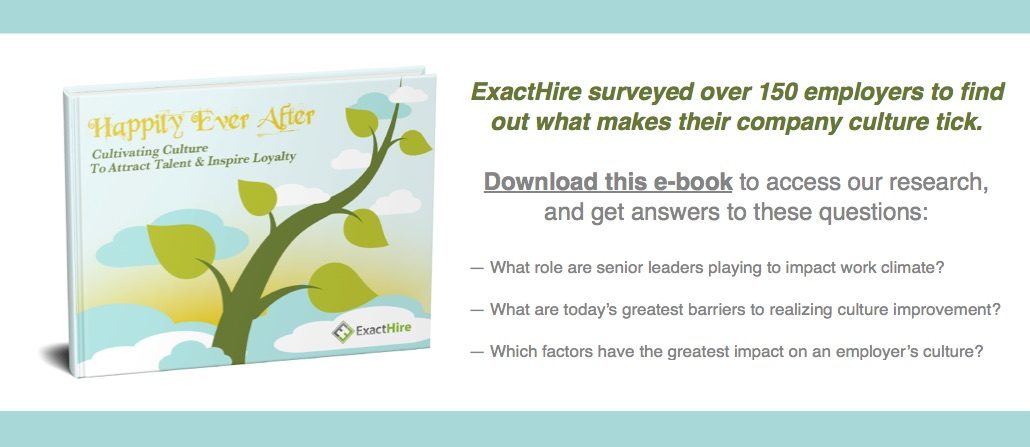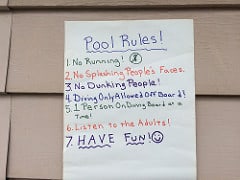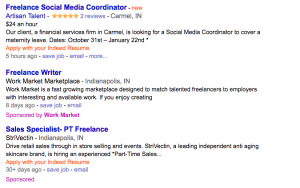7 Catalysts for Developing an Enviable Company Culture
Be intentional. That’s it. Shortest blog ever, right?
Let’s at least call intentionality the prerequisite for positive culture development. While it is true that you can’t force culture because it happens (insert buzz word) organically, purposefully paying attention to the actions and behaviors an organization takes that affect culture is like putting Miracle-Gro on your cherry tomato container plant. It just makes things turn out more favorably. In this blog, I’ll focus on seven intentional behaviors that can agreeably impact the attitudes people have about your organization’s culture. Let’s get fertilizin’.
1 – Senior leadership’s voice and leadership incubation
Your company’s management team sets the tone. Hopefully it’s melodically dependable like Straight No Chaser.
Or, maybe your managers’ behavior and communication falls flat…or not at all. Especially in fast growth companies, it’s easy for senior leaders to be wrapped up in the operations and investment pipeline for the business, and to just Band-Aid employee engagement initiatives. However, a mentality that stalls culture-focused activities until a later date once the company has established itself is a mentality that finds itself with an unintended and often undesirable culture. In contrast, a company that appreciates how culture evolves alongside operational processes and growth spurts right from the inception of an organization is one that is agile enough to dynamically affect its culture’s direction. Moreover, the latter organization will not be left trying to convince employees that “this time, culture will be better/different/important.” A sad repercussion of becoming intentional later in the game is that members of your organizational ecosystem will be more resistant to and skeptical of change.
Senior leaders forge the habits that inherently shape culture. Some may reflect the personal habits of the founders, while others become necessity based on the industry. Regardless of the habits, recognize and embrace them. Then, use them as a foundation for developing tomorrow’s senior leaders. Sentiments about company culture take a turn for the worse when up and coming managers are out of tune with core organizational habits–often because no initiative exists to groom their development.
Consider the following contrasting organizational habits and examples of how they may shape culture:
- Risk taking vs. risk aversion and stability – the willingness to accept external venture capital funding or the choice to be entirely self-funded
- Open book transparency vs. closed books – the responsibility to better educate employees about “the numbers” or the consequence that employees will invent their own ideas about company solvency
- Compliance-driven vs. relative nonconformity – the necessity to conform to expectations and/or government/industry regulations or the latitude to go in any/many direction(s)
- Deference to history vs. the open road ahead – the tradition of celebrating a long-standing history of accomplishment or the desire to forget the past and start with a clean slate
- Liberal work schedule autonomy vs. traditional 9 to 5 – the promotion of attractive work-life balance or the adherence to a standardized, brick and mortar schedule
2 – Value-based approach to culture evolution…maybe even revolution
Every company has values, they just aren’t always artfully framed and displayed on the office wall. But what matters more than using them as wall decorations is that they become an undeniable presence in your work operations. I’ll be honest, we’ve got some work to do on this front at ExactHire. I think we already have a distinctive culture which I enjoy; however, we haven’t specifically called out our organizational values (Alas, it’s a Q3 goal this year!). I think part of the struggle for us and other businesses is that if we make the effort to commit to our official values, we don’t want to fall short of supporting them and run the risk of having meaningless wall hangings. That can happen if companies approach the value conversation with their ideas of “aspirational values” (according to Patrick Lencioni), but not if they embrace the gritty, raw nature of their existing core values. For example, being “candid even when times are tough” doesn’t sound as nice as “integrity” (in gold lettering on stamped leather) but it may better describe your business, and if so, wear your pieces of flair proudly! And by the way, all companies should just omit “integrity” from their value lists because I think we can assume all companies should have it as a baseline “no duh” value.
So let’s say you don’t have any defined values yet. Where do you start? Only the senior leadership team should draft and determine the corporate values. Involving the entire company, whether via open discussion or survey, is a journey down a long, meandering path that results in vanilla values…and ones that won’t necessarily recognize the existing habits of the company.
Once senior leaders determine values, they should simmer on them for a few months before announcing them to the rest of the staff. The point of the waiting period is for management to intentionally work to model the values for the workforce and make sure they fit before outing them to the entire company.
Eventually, employees will help interpret the values through behaviors that impact company culture. The key to sustaining this is to recognize efforts that align with values. For example, if an organization happens to value proactive social communication, then appoint someone to create and post celebratory image posts to Twitter whenever a teammates crushes an important goal. Take it a step further by periodically recognizing individual employees who specifically support your different values through their actions. Or maybe have everyone wear black and white to celebrate “candor” day per my previous value example (“Divergent,” anyone?). Okay, that one was silly. But on a serious note, by being accountable to your values your organization will naturally foster a culture that supports your objectives.
3 – Communicate and empower involvement to build your community
A culture is really like a community too, isn’t it? And if you think about what makes all the communities of which you are a part thrive, I bet communication is at the top of the list. Being aware of all the happenings in your community is really what makes you feel comfortable. My husband and I have lived in our current neighborhood for ten years, but it has only been in the last three to four years that I have really felt engaged in our community. This is primarily due to a notable increase in communication now that we’re more involved in school activities (kids are that age now), kid sports, church committees and neighborhood HOA meetings. Because we know all the latest information about the activities in which we are involved, we are more engaged in those activities and empowered to participate.
Expect the same effect by employing more regular communication in your organization. Senior leaders should regularly address employees about what’s going on with the company, and HR and hiring managers should make sure that newly hired employees are added to recurring meeting requests and newsletter distribution lists. Be certain that communication habits align well with core values, and setting that example starts at the top. For a traditional banking institution that may mean formal notices in employees’ mailboxes, while a completely distributed workforce of remote employees may rely on messaging via a corporate intranet or a chat platform.
4 – Standardize training, but still champion individuality
Do you have “Ambassadors of Quan” conducting training for new employees and succession planning purposes? Or…just warm bodies carrying out this critical activity?
The quality and complexity of your training efforts directly impact the degree to which employee actions align with corporate values, and therefore, the extent to which your culture is desirable. Be sure to invest time to train your trainers so that a relatively consistent, comprehensive experience is available to trainees; however, engage trainers in the effort by allowing them to leave their own unique mark on the activity, as well. This may include latitude in methods for testing the retention of knowledge and/or strategies for gathering continuous feedback to improve training activities–both critical exercises.
5 – Hire and onboard with a laser focus on job fit
Let’s not forget that a significant driver of company culture is the workforce, itself. When it comes to hiring new employees, make sure that candidates will jive well with your values. To do so, incorporate behavioral-based questions into the interview process that will elicit whether a candidate’s own values will have synergy with your organization’s set. It can be easy to hire a rock star candidate that has the highly technical skills necessary for a role, but if his/her attitudes will start an internal riot within the company the best move is to move on to another person.
Beyond the initial interviews, create opportunities for candidates to proactively demonstrate their behaviors and attitudes by inviting them to job shadow prior to an offer. Additionally, employee assessments will give you a glimpse into the behavioral hardwiring of an individual so that you may ask targeted questions that will help you clear up any remaining uncertainty about an applicant. Many applicant tracking systems can make these additional steps easy by integrating assessment tools within one hiring software interface.
Achieving optimal job fit doesn’t stop with an employment offer to the top candidate. Use the employee onboarding process to have discussions with new hires about core values and how they support objectives and catalyze your culture. Consider a formal mentoring program that pairs new employees with existing employees who especially exemplify values and champion culture. Another fun activity during the employee onboarding phase would be to invite new hires to complete a scavenger hunt during which they complete value-aligned activities at the organization. For example, if cross-departmental collaboration is cherished at the company, then new hires might be prompted to Pokemon-Go (gasp!) over to other departments’ work areas in order to learn how their roles interface…while catching an elusive animated character, of course. Make sure these culture-enriching activities don’t fall through the cracks by creating a workflow specific to your organization with an employee onboarding software tool.
6 – Reward culture evangelism
Do this by recognizing and celebrating value alignment. If employees are praised for representing corporate values and intentionally nurturing culture, then they will want to keep doing it. Recognize what motivates different employees as it is the key to unlocking a new level of productivity and engagement. At ExactHire, being a smaller business, many of us are motivated by seeing one’s individual impact on the work of the entire company, for example, so we have monthly meetings in which we review financials, celebrate progress on individual and departmental goals and plan the roadmap for the next quarter together.
Recognition should be appropriately customized for the department or individual to which it is directed. Additionally, be specific with praise (no boiler plate email templates please!) so that one has clarity on the exact behavior that resulted in commendation. Be sure to explain the impact of one’s efforts, and do so in a timely fashion. For example, if your business has cultivated a culture of responsiveness then you certainly don’t want a supervisor missing the window of time for maximizing the appreciation an employee may feel for his/her efforts. The thank you note that is received three months after the birthday party doesn’t quite mean as much does it? That kind of misstep forms cracks in the authenticity of an organization’s culture.
7 – Make sure feedback doesn’t land in a black hole
Evolution. Dynamicism. Relevancy. Three adjectives I’d use to describe company culture nirvana. But you can’t get to Shangri La by sticking your head in the sand and going about business as usual. You must continuously evaluate your culture-minded activities and organizational engagement as a whole in order to keep your culture healthy.
Collect feedback in a way that supports your core values. For some this may mean periodic in-person focus groups where one employee’s idea can feed off another’s in a public forum. For others, weekly “pulse surveys” that prompt anonymous feedback on just one or two questions at a time may be ideal. Plus, don’t forget the value of human resources staff and management keeping their ear to ground and informally gathering feedback everyday.
Mine your feedback for hidden gems by collaborating with others to unearth the ideas that will become the next culture-focused priorities or experiments for your company. Keep in mind that one idea doesn’t fit all and that employees will be motivated by different activities and opportunities. Their opinions may be formed based on past employers’ (perhaps failed) culture efforts and generational differences, among other factors.
Most importantly, communicate what you are doing with the feedback to your workforce! Depending on corporate values related to transparency, you may share all of the feedback or just highlight the ideas that are being implemented. The point is that you communicate action steps resulting from the input and then promote and recognize the worth of the contributions. Report on how ideas have changed the company in the future, as well.
With these seven catalysts in mind, you will put your organization in a better position to synthesize the kind of culture that will attract talent from your competitors and engage employees to take the organization to new heights.









